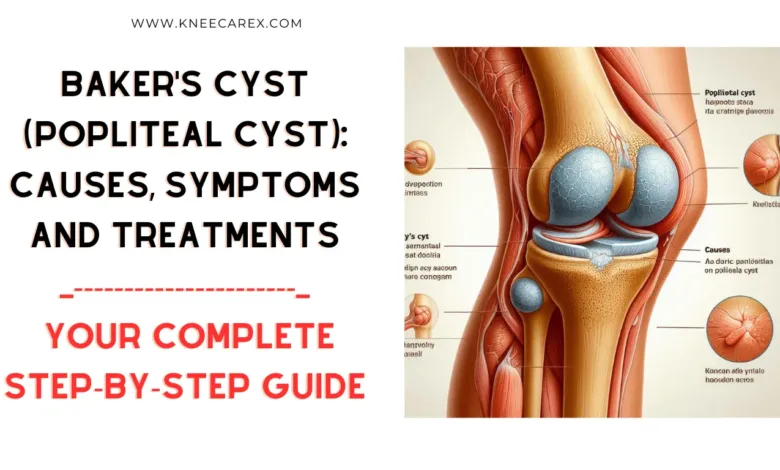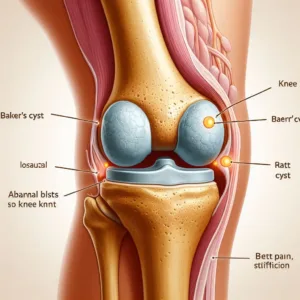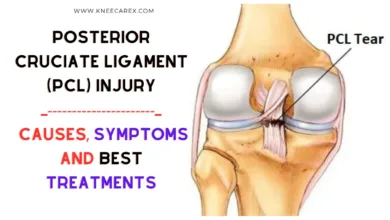Baker’s Cyst (Popliteal Cyst): Causes, Symptoms and Treatments

Baker’s cyst, also known as popliteal cyst, is a condition that affects the knee joint and can cause discomfort and limited mobility for those affected. Understanding this condition’s causes, symptoms, and effective treatments is crucial to managing its impact on daily life. In this article, we will delve into the complexities of Baker’s cyst to provide comprehensive insights into its nature and how individuals can seek relief from its symptoms.
Contents
- 1 What is a Baker’s cyst?
- 2 Causes and Risk Factors
- 3 Symptoms and Diagnosis
- 4 Treatment Options
- 5 Prevention and Lifestyle Tips
- 6 FAQ’s
- 6.1 What is the difference between a Baker’s cyst and a popliteal cyst?
- 6.2 How do you treat a popliteal cyst on the knee?
- 6.3 What happens if a Baker’s cyst is left untreated?
- 6.4 Does a popliteal cyst require surgery?
- 6.5 What happens if a Baker’s cyst bursts?
- 6.6 Is walking good for a ruptured Baker cyst?
- 6.7 What happens if a Baker’s cyst is left untreated?
- 6.8 Can a Baker’s cyst dissolve on its own?
- 6.9 What is the treatment protocol for Baker’s cyst?
- 6.10 What is the technique for Baker cysts?
- 6.11 What are the treatment options for Baker’s cyst?
- 6.12 What is the proper name for a Baker cyst?
- 6.13 What is the surgical approach to a Baker’s cyst?
- 6.14 What is the best way to get rid of Baker’s cyst?
- 6.15 What is the protocol for Baker’s cyst?
- 6.16 Can a Baker’s cyst be surgically removed?
- 6.17 Can a Baker’s cyst be complex?
- 6.18 Is a 4 cm Baker’s cyst giant?
- 6.19 What are the complications of a Baker cyst?
- 6.20 What is the DD of the Baker cyst?
- 6.21 Will an MRI show a Baker’s cyst?
- 6.22 How is a Baker’s cyst confirmed?
- 6.23 Is a 4 cm Baker’s cyst giant?
- 6.24 What are the USG findings of a Baker cyst?
- 7 Conclusion: Baker’s Cyst (Popliteal Cyst)
What is a Baker’s cyst?

The presence of a Baker’s cyst can sometimes lead to mild to moderate pain and limited range of motion in the affected knee. It is essential to understand that while treating the underlying condition is vital for managing symptoms, addressing the actual cyst itself may also be necessary in severe cases. As with any medical issue, seeking guidance from a healthcare professional is crucial to receiving an accurate diagnosis and developing an appropriate treatment plan tailored to your needs.
Synovitis of the Knee: Causes, Symptoms and Best Treatments
Causes and Risk Factors
The development of a Baker’s cyst, also known as a popliteal cyst, is commonly associated with underlying knee conditions. One of the primary causes is an accumulation of synovial fluid in the bursa sac behind the knee joint. This can be triggered by conditions such as rheumatoid arthritis or osteoarthritis, leading to increased production of synovial fluid within the joint. Additionally, injuries or trauma to the knee, such as meniscal tears or cartilage damage, can also contribute to forming a Baker’s cyst.
Symptoms and Diagnosis

Diagnosing a Baker’s cyst typically involves a physical examination, where a healthcare provider will assess the size and location of the swelling as well as your range of motion. Imaging tests like ultrasound or MRI may also be used to confirm the presence of a cyst and rule out other potential causes for your symptoms. By understanding these distinct symptoms and diagnostic procedures, individuals can seek timely medical attention and begin treating their Baker’s cyst appropriately.
Treatment Options
When treating Baker’s cyst, there is no one-size-fits-all approach. The treatment options range from conservative measures such as rest, ice, and elevation to more aggressive interventions like steroid injections or surgical removal. A key consideration in choosing the appropriate treatment is the severity of the symptoms and the underlying cause of the cyst.
For some individuals, managing their underlying knee condition may be sufficient to alleviate the symptoms of Baker’s cyst. This could involve physical therapy to strengthen the surrounding muscles and improve joint function. In more severe cases, fluid aspiration from the cyst or corticosteroid injections into the knee joint may be recommended to reduce swelling and pain. Ultimately, a healthcare professional should carefully assess each case to determine the most suitable treatment plan for optimal recovery and long-term management.
Prevention and Lifestyle Tips

FAQ’s
What is the difference between a Baker’s cyst and a popliteal cyst?
Baker’s cyst and popliteal cyst are terms often used interchangeably to describe the same condition, but some subtle differences are worth noting. While both refer to a fluid-filled swelling at the back of the knee, Baker’s cyst arises explicitly from the knee joint capsule. In contrast, a popliteal cyst can develop from several structures within or around the knee. Moreover, a Baker’s cyst is usually associated with an underlying knee condition such as arthritis or meniscal tear, while a popliteal cyst may not always have an identifiable cause.
How do you treat a popliteal cyst on the knee?
Popliteal cysts, also known as Baker’s cysts, can be a source of discomfort and reduced mobility for many individuals. While they often stem from underlying conditions such as arthritis or knee injuries, treating the cyst is essential for managing symptoms. One approach involves managing the underlying condition, which may include physical therapy to strengthen surrounding muscles and reduce swelling. Additionally, ice packs and compression bandages can help alleviate the pain and inflammation associated with the popliteal cyst.
What happens if a Baker’s cyst is left untreated?
Leaving a Baker’s cyst untreated can lead to complications and further discomfort for the individual. Without proper treatment, the cyst may continue to grow in size, causing increased pressure on surrounding tissues and nerves. This can result in persistent pain, swelling, and limited mobility in the affected joint. Furthermore, if the cyst ruptures or leaks fluid into the calf muscle, it can cause sharp pain, redness, and inflammation in the leg.
Does a popliteal cyst require surgery?
Popliteal cyst, also known as Baker’s cyst, is a common condition that causes a fluid-filled swelling at the back of the knee. Whether or not a popliteal cyst requires surgery depends on the severity of the symptoms experienced by the individual. In some cases, conservative treatments such as rest, ice, elevation, and physical therapy may be sufficient to reduce the pain and swelling associated with the cyst. However, surgical intervention may be considered if these non-invasive methods fail to provide relief.
What happens if a Baker’s cyst bursts?
When a Baker’s cyst bursts, it can cause significant pain and swelling in the knee area. The sudden release of fluid from the cyst can lead to inflammation and discomfort, making it difficult to bend or straighten the knee. Additionally, the burst may cause a feeling of tightness or stiffness in the affected leg, further complicating movement and daily activities.
Is walking good for a ruptured Baker cyst?
For a burst Baker’s cyst, walking can help since it increases blood flow, reduces stiffness, activates the lymphatic system, and strengthens the surrounding muscles. Take short walks at first, then progressively increase the length. A healthcare provider should be consulted before beginning any workout program. Walking gently can help with recovery and improve both mental and physical health, though results may differ from person to person.
What happens if a Baker’s cyst is left untreated?
If a Baker’s cyst is left untreated, it can lead to several complications that can significantly impact the individual’s quality of life. One potential consequence is chronic pain and discomfort in the affected knee, which may worsen over time. Additionally, the cyst may continue to grow and expand, causing increased pressure on surrounding tissues and potentially leading to limitations in movement and mobility.
Can a Baker’s cyst dissolve on its own?
A Baker’s cyst can dissolve independently, especially if the underlying cause, such as arthritis or a meniscus tear, is effectively treated. In some cases, reducing inflammation and swelling through rest and proper care can contribute to the gradual shrinkage of the cyst. Additionally, physical therapy and exercises that strengthen the surrounding muscles help support the healing process and promote the natural dissipation of the cyst.
What is the treatment protocol for Baker’s cyst?
Physical therapy exercises and conservative treatments such as rest, elevation, and ice application are part of Baker’s cyst treatment. It could be advised to aspirate fluid or administer corticosteroid injections. Treating the underlying problem, such as meniscus tears or osteoarthritis, is critical. Surgical procedures such as knee arthroscopy or cyst excision may be explored in severe situations. It is imperative to consult a healthcare provider.
What is the technique for Baker cysts?
The technique for treating Baker cysts, also known as popliteal cysts, varies depending on the severity and symptoms of the individual. In mild cases, conservative approaches such as rest, ice, compression, and elevation (RICE) may be sufficient to reduce inflammation and alleviate discomfort. Physical therapy and exercises focused on strengthening the muscles around the knee can also help improve flexibility and reduce pressure on the cyst.
What are the treatment options for Baker’s cyst?
Baker’s cyst, also known as a popliteal cyst, can cause discomfort and limit mobility for individuals. Treatment options vary depending on the severity of the cyst and the symptoms experienced by the patient. In many cases, conservative approaches such as rest, ice, compression, and elevation (RICE) can help reduce the pain and swelling associated with the cyst. Physical therapy may also be recommended to improve flexibility and strengthen the muscles around the knee joint.
What is the proper name for a Baker cyst?
The condition known as a Baker cyst, named after Dr. William Morrant Baker, is typified by a buildup of synovial fluid behind the knee joint. Although it can happen to people without such problems, it is frequently associated with arthritis or knee injuries. According to a recent study, systemic inflammatory processes may impact Baker cysts. This could lead to new developments in prevention and targeted therapies for at-risk people, as well as novel approaches to treatment and management.
What is the surgical approach to a Baker’s cyst?
The surgical approach to a Baker’s cyst, also known as a popliteal cyst, involves a procedure known as cyst excision. This surgery is generally performed when the cyst does not respond well to non-surgical treatments such as rest, ice, and elevation. During the procedure, the surgeon makes an incision at the back of the knee and removes the cyst and any excess fluid or tissue contributing to its formation.
What is the best way to get rid of Baker’s cyst?
Effective treatment for Baker’s cysts includes rest, physical therapy, and lifestyle modifications. Inflammation and swelling can be decreased by resting the injured knee, avoiding activities that aggravate it, and using physical therapy to strengthen the affected knee’s muscles. Changing one’s lifestyle to include less strenuous exercise and weight loss can also help with symptoms. Temporary relief may be obtained with injection therapy employing hyaluronic acid or corticosteroids. Speak with a medical practitioner about the best course of action if surgery is required.
What is the protocol for Baker’s cyst?
When it comes to managing Baker’s cyst, the protocol usually involves a combination of conservative treatments and medical interventions. Conservative treatments may include rest, ice, compression, and elevation (RICE) to alleviate pain and swelling. Physical therapy exercises focused on strengthening the muscles around the knee can also help reduce symptoms and prevent a recurrence. In some cases, corticosteroid injections may reduce inflammation and relieve pain.
Can a Baker’s cyst be surgically removed?
Indeed, a Baker’s cyst can be surgically removed through a procedure known as excision of the cyst. This surgical option is considered when conservative treatments such as rest, ice, and physical therapy have failed to provide relief. During the surgery, the cyst is carefully excised from the back of the knee, and any underlying issues in the knee joint may also be addressed. It’s important to note that while surgical removal can help alleviate symptoms and improve mobility, it’s essential to address any underlying conditions contributing to the formation of Baker’s cyst to prevent its recurrence.
Can a Baker’s cyst be complex?
Baker’s cyst, known as a popliteal cyst, is traditionally considered relatively straightforward. However, in some cases, it can become complex due to complications such as rupture or infection. These complexities can lead to increased pain, swelling, and limited mobility in the affected knee. Additionally, underlying conditions such as arthritis or cartilage tears can further complicate diagnosing and treating a Baker’s cyst.
Is a 4 cm Baker’s cyst giant?
A popliteal cyst, or 4 cm Baker’s cyst, can be uncomfortable and possibly cause problems. The affected knee may result in discomfort, edema, and a restricted range of motion. Getting medical help is essential for a precise diagnosis and course of therapy. Larger cysts have the potential to burst or leak fluid, which could cause discomfort and other issues. To effectively treat the cyst and prevent further injury to the knee joint, it is imperative to monitor its size.
What are the complications of a Baker cyst?
Popliteal cysts, another name for Baker’s cysts, can cause excruciating pain, swelling, and fluid leakage in the knee region. Cysts can squeeze nearby structures if left untreated, reducing blood flow and harming nerves. Treating the cyst and the underlying ailment is essential for avoiding long-term consequences if it is linked to rheumatoid arthritis or osteoarthritis.
What is the DD of the Baker cyst?
Diagnosing a Baker’s cyst relies on carefully considering the patient’s symptoms and a physical examination. Differential diagnoses for a Baker’s cyst include deep vein thrombosis (DVT), popliteal artery aneurysm, cellulitis, mass lesions, and synovial tumors. Distinguishing characteristics such as heat, redness, and severe pain may indicate cellulitis or DVT rather than a Baker’s cyst.
Will an MRI show a Baker’s cyst?
An MRI is a highly effective method for detecting and diagnosing a Baker’s cyst. This imaging technique allows for clear visualization of the knee joint and surrounding tissues, making it possible to identify the presence and size of a Baker’s cyst. Additionally, an MRI can show any associated damage to the knee joint, such as meniscal tears or arthritis, which may contribute to the cyst’s development. By providing detailed cross-sectional images, an MRI helps medical professionals accurately assess the condition and plan appropriate treatment strategies for patients with Baker’s cyst.
Best Radiologists for x-rays and ultrasounds near You
How is a Baker’s cyst confirmed?
A physical examination, magnetic resonance imaging, and ultrasound are used to diagnose Baker’s cysts. Palpating the region behind the knee to feel for soreness or swelling is part of the physical examination. Ultrasound can differentiate the cyst from other disorders, such as tumors or blood clots. With the ability to assess size, location, and any consequences, MRI offers precise pictures. These diagnostic techniques direct the development of treatment plans for people who are uncomfortable or limited.
Is a 4 cm Baker’s cyst giant?
A 4-cm Baker’s cyst can be considered relatively large and may cause discomfort or pain in the affected knee. While some people with Baker’s cysts may experience minimal symptoms, others might find that larger cysts lead to increased swelling, stiffness, and limited mobility. It’s important to note that the size of the cyst alone does not necessarily dictate the severity of symptoms; factors such as location and pressure on surrounding structures also play a significant role.
What are the USG findings of a Baker cyst?
USG findings of a Baker cyst can provide valuable insights into this common knee condition. Ultrasonography typically reveals a well-defined, fluid-filled mass in the popliteal fossa from the semimembranosus gastrocnemius bursa. This non-invasive imaging technique allows for accurate localization and characterization of the cyst, making it an essential tool for diagnosis and monitoring.
Conclusion: Baker’s Cyst (Popliteal Cyst)
In conclusion, Baker’s cyst, while often considered a benign condition, can cause significant discomfort and limitations in mobility for those affected. It is essential for individuals experiencing symptoms such as swelling or tightness behind the knee to seek medical evaluation to determine the underlying cause and appropriate treatment. Furthermore, understanding that a Baker’s cyst may be a symptom of an underlying knee condition, such as osteoarthritis or rheumatoid arthritis, emphasizes the importance of addressing the cyst itself and the root cause.




